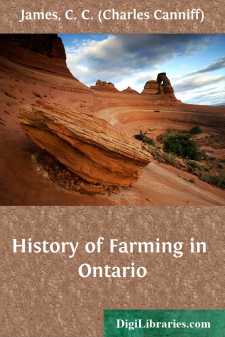Categories
- Antiques & Collectibles 13
- Architecture 36
- Art 48
- Bibles 22
- Biography & Autobiography 813
- Body, Mind & Spirit 142
- Business & Economics 28
- Children's Books 17
- Children's Fiction 14
- Computers 4
- Cooking 94
- Crafts & Hobbies 4
- Drama 346
- Education 46
- Family & Relationships 57
- Fiction 11829
- Games 19
- Gardening 17
- Health & Fitness 34
- History 1377
- House & Home 1
- Humor 147
- Juvenile Fiction 1873
- Juvenile Nonfiction 202
- Language Arts & Disciplines 88
- Law 16
- Literary Collections 686
- Literary Criticism 179
- Mathematics 13
- Medical 41
- Music 40
- Nature 179
- Non-Classifiable 1768
- Performing Arts 7
- Periodicals 1453
- Philosophy 64
- Photography 2
- Poetry 896
- Political Science 203
- Psychology 42
- Reference 154
- Religion 513
- Science 126
- Self-Help 84
- Social Science 81
- Sports & Recreation 34
- Study Aids 3
- Technology & Engineering 59
- Transportation 23
- Travel 463
- True Crime 29
History of Farming in Ontario
Categories:
Description:
Excerpt
HISTORY OF FARMING
The Land and the People
From the most southern point of Ontario on Lake Erie, near the 42nd parallel of latitude, to Moose Factory on James Bay, the distance is about 750 miles. From the eastern boundary on the Ottawa and St Lawrence Rivers to Kenora at the Manitoba boundary, the distance is about 1000 miles. The area lying within these extremes is about 220,000 square miles. In 1912 a northern addition of over 100,000 square miles was made to the surface area of the province, but it is doubtful whether the agricultural lands will thereby be increased. Of this large area about 25,000,000 acres are occupied and assessed, including farm lands and town and city sites. It will be seen, therefore, that only a small fraction of the province has, as yet, been occupied. Practically all the occupied area lies south of a line drawn through Montreal, Ottawa, and Sault Ste Marie, and it forms part of the great productive zone of the continent.
The next point to be noted is the irregularity of the boundary-line, the greater portion of which is water—Lakes Superior, Huron, Erie, Ontario, the St Lawrence River, the Ottawa River, James Bay, and Hudson Bay. The modifying effect of great bodies of water must be considered in studying the agricultural possibilities of Ontario.
Across this great area of irregular outline there passes a branch of the Archæan rocks running in a north-western direction and forming a watershed, which turns some of the streams to Hudson Bay and the others to the St Lawrence system. An undulating surface has resulted, more or less filled with lakes, and almost lavishly supplied with streams, which are of prime importance for agricultural life and of incalculable value for commercial purposes. To these old rocks which form the backbone of the province may be traced the origin of the large stretches of rich soil with which the province abounds.
An examination of the map, and even a limited knowledge of the geological history of the province, will lead to the conclusion that in Ontario there must be a wide range in the nature and composition of the soils and a great variety in the climatic conditions. These conditions exist, and they result in a varied natural production. In the extreme south-western section plants of a semi-tropical nature were to be found in the early days in luxurious growth; while in the extreme north, spruce, somewhat stunted in size and toughened in fibre, are still to be found in vast forests.
It is with the southern section, that lying south of the Laurentian rocks, that our story is mainly concerned, for the occupation and exploitation of the northland is a matter only of recent date. Nature provided conditions for a diversified agriculture. It is to such a land that for over a hundred years people of different nationalities, with their varied trainings and inclinations, have been coming to make their homes. We may expect, therefore, to find a great diversity in the agricultural growth of various sections, due partly to the variety of natural conditions and partly to the varied agricultural training of the settlers in their homelands....


